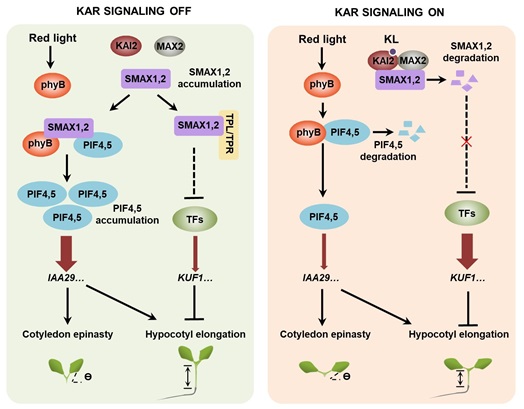Researchers led by Dr. WANG Lei and WANG Bing from the Institute of Genetics and Developmental Biology of the Chinese Academy of Sciences revealed that the non-transcriptional activity of SMAX1 and SMXL2 mediates the karrikin (KAR) signaling and red light response in
Arabidopsis. The study was published in Molecular Plant on May 27, 2024 (
https://doi.org/10.1016/j.molp.2024.05.007).
KARs, a class of butenolide molecules, are found in smoke and trigger seed germination mainly in fire followers, the plant species that emerge rapidly after wildfires. KARs also regulate many aspects of plant development and environmental responses, including hypocotyl elongation, leaf shape, root development, symbiosis with arbuscular mycorrhizal fungi, and resistance to drought, salt, and heat stress. SMAX1 and SMXL2 function as repressor proteins in the KAR signaling pathway; however, the mechanism by which SMAX1 and SMXL2 regulate KAR signaling is still largely unknown.
This study systematically identified proteins that interact with SMAX1 and SMXL2 via mass spectrometry (IP-MS) analysis. PIF4 and PIF5 directly interact with SMAX1 and SMXL2 in plants and positively regulate KAR signaling, suggesting that PIF4 and PIF5 are new components involved in KAR signaling pathway. Importantly, SMAX1 and SMXL2 display transcriptional repression activity in an EAR motif-dependent manner; however, they cannot repress the transcriptional activity of PIF4 and PIF5. Biochemical analysis indicated that SMAX1 and SMXL2 interact with phyB and inhibit the interactions of phyB with PIF4 and PIF5, resulting in the accumulation of PIF4 and PIF5 proteins.
More interestingly, approximately one-third of the DEGs (964 genes) in the smax1 smxl2 double mutant showed comparable expression levels in pSMAX1:SMAX1ΔEAR-GFP/smax1 smxl2 and the wild type, indicating that the non-transcriptional regulatory activity of SMAX1, which is independent of its EAR motif, has a global effect on gene expression. Furthermore, the non-transcriptional regulatory activity of SMAX1 regulates the expression of genes downregulated in smax1 smxl2 in a PIF4- and PIF5-dependent manner. Among these genes, IAA29 is a direct target of PIF4 and PIF5 and play important roles in red light responses. The KAR analog GR24ent-5DS repressed the expression of IAA29 in a PIF4- and PIF5-dependent manner while GR24ent-5DS induced the expression of KUF1, which is unrelated with PIF4- and PIF5, in a PIF4- and PIF5-independent manner.
Transcriptional activity assays revealed that SMAX1 enhances the transcriptional activity of IAA29 promoter in a PIF4- and PIF5-dependent but EAR motif-independent manner, while SMAX1 enhances the transcriptional activity of the KUF1 promoter in a PIF4- and PIF5-independent but EAR motif-dependent manner. Genetic analysis further showed that the overexpression of IAA29 partially restored the phenotype of hypocotyl elongation and cotyledon epinasty in smax1smxl2, indicating that IAA29 is located downstream of SMAX1 and SMXL2.
Taken together, these results indicate that SMAX1 mediates KAR signaling through protection of PIF4 and PIF5 from degradation or by direct transcriptional regulation of downstream genes. The discovery of dual functions of SMAX1 reveals the molecular mechanisms underlying how KAR signaling regulates downstream gene expression, especially in response to red light in Arabidopsis.
A proposed model for the non-transcriptional and transcriptional regulatory activities of SMAX1 and SMXL2 that mediate KAR-regulated response to red light (Image by Center for Agricultural Resources Research, IGDB)
Contact:
Dr. WANG Lei
Center for Agricultural Resource Research, Institute of Genetics and Developmental Biology, Chinese Academy of Sciences
Dr. WANG Bing
Institute of Genetics and Developmental Biology, Chinese Academy of Sciences
 A proposed model for the non-transcriptional and transcriptional regulatory activities of SMAX1 and SMXL2 that mediate KAR-regulated response to red light (Image by Center for Agricultural Resources Research, IGDB)Contact:Dr. WANG LeiCenter for Agricultural Resource Research, Institute of Genetics and Developmental Biology, Chinese Academy of SciencesDr. WANG BingInstitute of Genetics and Developmental Biology, Chinese Academy of Sciences
A proposed model for the non-transcriptional and transcriptional regulatory activities of SMAX1 and SMXL2 that mediate KAR-regulated response to red light (Image by Center for Agricultural Resources Research, IGDB)Contact:Dr. WANG LeiCenter for Agricultural Resource Research, Institute of Genetics and Developmental Biology, Chinese Academy of SciencesDr. WANG BingInstitute of Genetics and Developmental Biology, Chinese Academy of Sciences CAS
CAS
 中文
中文




.png)
